News & Blogs
The origin of Children's Day dates back about 1,300 years
Hina Dolls vs. May Dolls
Carp eventually transforms into a dragon after a hefty challenge
Herbal bath to obtain energy from the season
Traditional rice cake treats, Kashiwa Mochi and Chimaki
The origin of Children's Day is a seasonal festival derived from Yin-Yang Theory and the Five Elements.
Children's Day on May 5th is a national holiday stipulated by Japanese law in 1948 to cherish children’s personalities and happiness while respecting their mothers. Because May 5th was initially celebrated as "Tango-no-Sekku (端午の節句)," a day to pray for the healthy growth and happiness of boys, it was designated as Children's Day, a day to celebrate all children, not just boys.
Based on the lunar calendar, "Tango (端午)" literally means “the first day of the horse” in May, and "Sekku (節句)" refers to a milestone day tied to seasonal transitions. Sekku, seasonal festivals derived from the Chinese Yin-Yang Theory and the Five Elements introduced in the Nara period (around the 8th century), have long been essential milestones to celebrate annual events. Among eight festivals originally introduced, five festivals are rooted in Japan to the present day. The Japanese celebrate such milestone dates by making offerings and performing rituals to dispel evil spirits in the hope of good health, good harvest, and prosperity for our descendants. The five seasonal festivals are January 7th (Feast of the Seven Herbs of Health), March 3rd (Doll's Festival), May 5th (Children's Festival), July 7th (Festival of the Weaver), and September 9th (Chrysanthemum Festival).
Today we invite you to the upcoming celebration of the Children's Festival.
Festive May Dolls are displayed to pray for healthy growth and life-long success.
In a previous article, we shared the Japanese tradition of the Girls' Festival, where people display Hina Dolls for girls’ happiness and healthy growth on March 3rd. In contrast, May 5th is the Children's Festival to celebrate boys’ healthy development, success, and advancement by displaying samurai armors, helmets, and warrior figures called May dolls or May figures. The display of armors and helmets originated in the samurai society of the Sengoku Period (13th-15th century), a time of constant warfare. At that time, samurai celebrated a boy’s birth with a banner depicting legendary heroes or a gift of a suit of armor to the newborn baby boy. This custom is supposedly tied to the samurai’s tradition of taking the armors from storage to perform annual maintenance in early May in the lunar calendar. Armors and helmets are essential equipment for warriors to protect themselves during battles. Thus families wished the boys to grow healthy and happy, free from illness and accidents, by displaying armors on Children’s Day (formerly Boys' Day.)
Samurai dolls are made after famous historical figures believed to guard young boys against misfortunes. A menacing armed warrior used to be displayed in the past, but nowadays, armed dolls with peaceful and young appearances are preferred. The dolls are made to look like brave heroes in children’s tales.
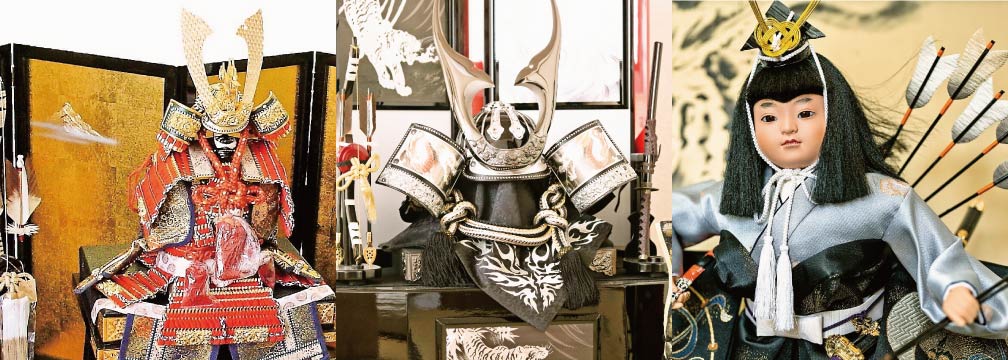
The carp streamer is to wish children health and resilience to overcome challenges in life.
There is a children's song called "Koi Nobori (carp streamer鯉のぼり)" that most Japanese can hum. The song goes:
Carp streamers, high above the roof
The big one must be the father
The little ones must be his children
All are swimming in the sky very happily.
Lyrics: Miyako Kondo, Composed by unknown
This song expresses a carp streamer displayed outdoors on a tall pole. Carp-shaped windsocks flow as if swimming in the sky when the wind blows.
When the song "Koi Nobori" was composed (around 1931), the black and red carps represented father and children. When the carp streamer was first displayed in the Edo period (17th-19th century), the pole carried only one black carp signifying a newborn boy. Later, red carp were added, indicating children in addition to the black carp as their father. In recent years, blue and green were also added, with the black carp representing the father, the red carp the mother, and the children the blue and green. Nowadays, orange and pink carp are added to represent the whole family. Due to changes in housing conditions, fewer and fewer households are installing carp streamers higher than the roof. Instead, they display a miniature, indoor version of carp streamers to celebrate the seasonal event.
Generally, the carp windsocks are attached to a flagpole topped with a ball-shaped spinning vane and a pair of arrow-spoked wheels. The top streamer is a colorful non-carp windsock, followed by black carp, red carp, and blue carp in order of size. The ball-shaped spinning vane, called “a celestial sphere,” and arrow-spoked wheels are designed to keep spinning with the wind blow. The celestial sphere is believed to inform the Universe of children’s presence in the family, while the arrow wheels are meant to drive away evil spirits. The top streamer features five colors of blue, red, yellow, white, and black, derived from the five natural elements based on Chinese Yin and Yang principles to protect the family. According to a legend introduced from China, a carp becomes a dragon and ascends to the sky after climbing a Dragon’s Gate waterfall. The carp-shaped streamers are to wish children health and resilience to overcome challenges in life to be successful.
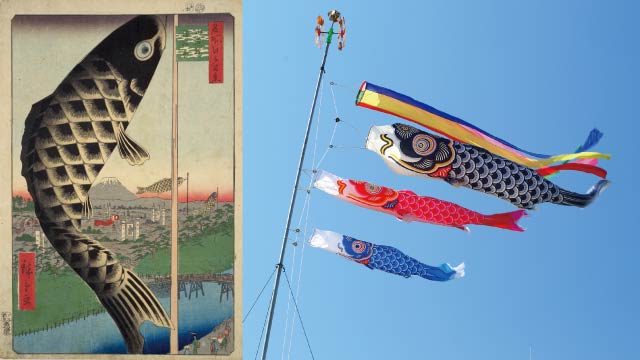
Herbal bath to celebrate the special day while obtaining energy from the season
The Japanese, known to love taking baths, bathe in "shobu-yu (菖蒲湯)," a bath with sweet flag leaves and roots in a bathtub on Children's Day. Sweet flags are often confused with iris because both can be referred to as shobu. The shapes of the leaves are even similar, but the flowers are pretty different; the sweet flag's flowers are surprisingly unembellished.
There are three reasons why sweet flags are favored on Children's Day. Firstly it has a refreshing fragrance. Since they are believed to ward off evil spirits, sweet flags are sometimes hung under the eaves or placed under the pillows at bedtime. It is said that the grass also contains chemical compounds that promote blood circulation and rejuvenation and are optimal when added to the bath. The second reason is its sword-like shape. The last reason is its pronunciation identical to” warlike spirit” or “a match.” Both the form and pronunciation were favored in samurai society.
It is super simple to prepare a bath with sweet flag leaves since the leaves are available at most Japanese supermarkets when the Children's Day approaches. Many public bathhouses and spas also offer shobu-yu baths on May 5th. Along with the yuzu citrus bath on the winter solstice, this is a well-known bathing custom in Japan.
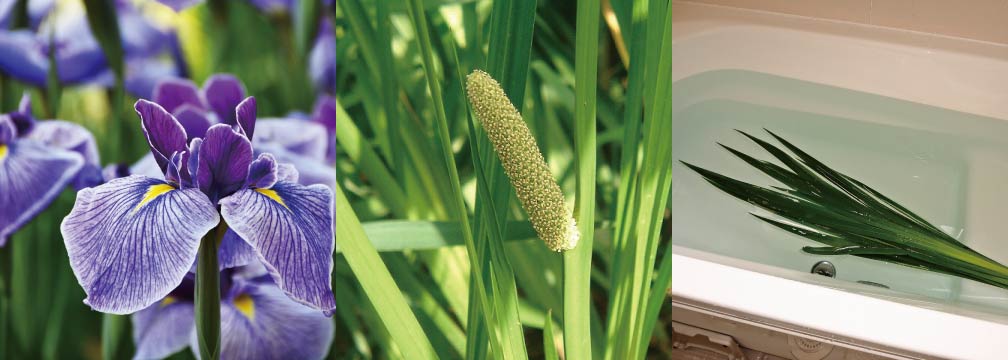
Kashiwa Mochi or Chimaki? Festive foods for the Children’s Day
Typical festive foods for Children's Day are Kashiwa Mochi (柏餅), a rice cake with sweet red bean paste filling wrapped in an oak leaf, and Chimaki (ちまき), a long, thin sweet dumpling wrapped in a Sasa (broad-leaf bamboo) leaf. There is a regional preference between Kashiwa Mochi and Chimaki.
Around the Nara period (around the 8th century), China introduced chimaki to Japan along with the concept of seasonal festivals. Since then, this sweet mochi treat has spread throughout the country. In the Edo period (17th-19th century), Kashiwa mochi, which is believed to be auspicious, became the mainstream of Edo (Tokyo) and other surrounded areas, whereas Kamigata (Kyoto) valued tradition and opted to celebrate the festival with chimaki. Such backgrounds established the region-specific preference for Kashiwa mochi in eastern Japan and chimaki in western Japan.
Chimaki is pronounced "zongzi” in Chinese, originating as an offering to a Chinese poet (屈原) who committed suicide out of concern for his country on May 5th some 2,300 years ago. The story goes that the poet was disgraced and forced to flee his country despite his actions of justice and patriotism. It is said that the public have mourned the poet by throwing rice wrapped in thatch leaves into the river, where the poet threw himself, wishing for the sacred thatch leaves to protect his soul from evil spirits. This was the origin of the Chinese custom of making chimaki (zongzi) on May 5th. Since the tradition was introduced to Japan, the thatch leaves have been taken place by bamboo leaves because they were used to wrap food, especially preserved foods, due to their antiseptic properties. Thus chimaki features its long, thin shape.
Kashiwa Mochi is Japan’s original rice cake wrapped in oak leaves, which emerged in Edo (former Tokyo). Although it is a deciduous tree, the oak maintains dead leaves in the branches through the winter until new leaves sprout in the spring. Because of such resilience, the oak is considered a tree of good luck in Japan, where deities dwell. The Japanese back then thought oak’s biological characteristics were associated with "the family line will not cease" and "prosperity of descendants." Thus, Kashiwa mochi became popular in Edo as an auspicious food promising festival.
The choice between Kashiwa Mochi and Chimaki varies from region to region. Today, however, Kashiwa mochi appears to be dominating the nation. Perhaps sweet red bean paste makes them preferable.
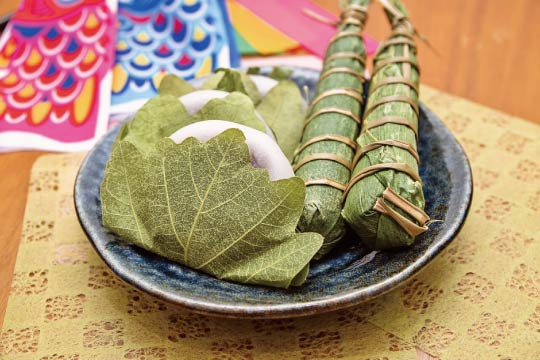
Now that you know the historical background of Chimaki, why not try making homemade chimaki using trehalose (TREHA®)? Broad-leaf bamboo leaves for chimaki are readily available at confectionery ingredient stores in Japan. If they are not available where you live, you can use parchment paper or plastic wrap instead. Rush grass is usually used to tie chimaki, but a cotton string or food-grade adhesive tape can be substituted. TREHA® makes chimaki featuring subtle sweetness and a long-lasting soft texture due to the properties such as low sweetness and moisture retention delay starch retrogradation. Chimaki could be shaped into many traditional shapes specific to each region throughout Japan, such as rhombus, triangle, bale, and the long, slender, cow-horn-like form. No matter how they are shaped, the bamboo leave wrapper of chimaki is usually tied with a string to be held in place. In addition, its size and shape make chimaki easy to grab and enjoy as a finger food without making fingers sticky. To eat the sweet dumplings inside, peel the leaves as you consume. The sweet dumpling can be seasoned with yomogi (mugwort) or include sweet red bean paste filling. In some regions, sweet dumplings are dusted with sweetened soybean flour (kinako). Please feel free to unleash your creativity, at the same time, be reminded that the mochi dough can be extremely hot right after microwaving.
[Ingredients]
Rice flour 120g
TREHA® 20g
Sugar 30g
Water 200g
[Directions]
Combine all ingredients in a microwave-safe bowl and mix until incorporated.
Loosely cover the mixture with plastic wrap and microwave (600W) for 2 minutes.
Fold the dough with a spatula until thoroughly incorporated.*
Cover with plastic wrap loosely and microwave for 1 minute.
Fold the dough with a spatula until thoroughly incorporated.*
Place the dough on a double-layered plastic wrap and knead 10 times. *
Shape the dough into cone shapes (60g each piece) and wrap them with bamboo leaves.
*The dough is extremely hot right after taking the dough out of the microwave. Be careful not to burn yourself.
We hope you enjoy this sweet Japanese treat rich in culture and festivity.
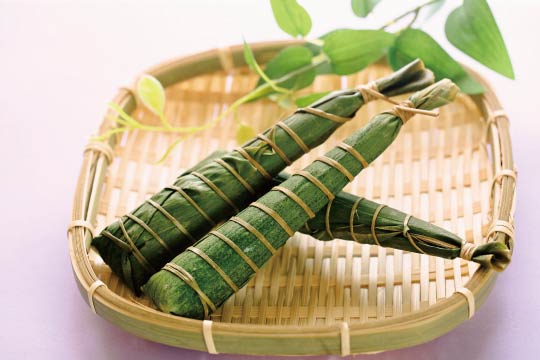
Did you find this blog interesting?
Please share it with your friends in the food service industry.
We regularly update the blog about the food culture of Japan, where TREHA® was discovered for culinary applications.
Click here and send us a message to subscribe.
Or hit us up on Instagram @trehalose_sensei!
You might also be interested in:
Japanese traditional food series 2: Chitose Ame, candy for healthy longevity (千歳飴)
Japanese traditional food series 3: Yuzu (柚子) and the winter solstice
Japanese traditional food series 4: Noodles on New Year's Eve (年越しそば)
Japanese traditional food series 5: Japanese traditional New Year’s dishes, Osechi-ryori (おせち料理)
Japanese traditional food series 6: Another traditional food for New Year’s celebration, mochi (餅)
Japanese traditional food series 13: Inari sushi offered to a deity of harvests

